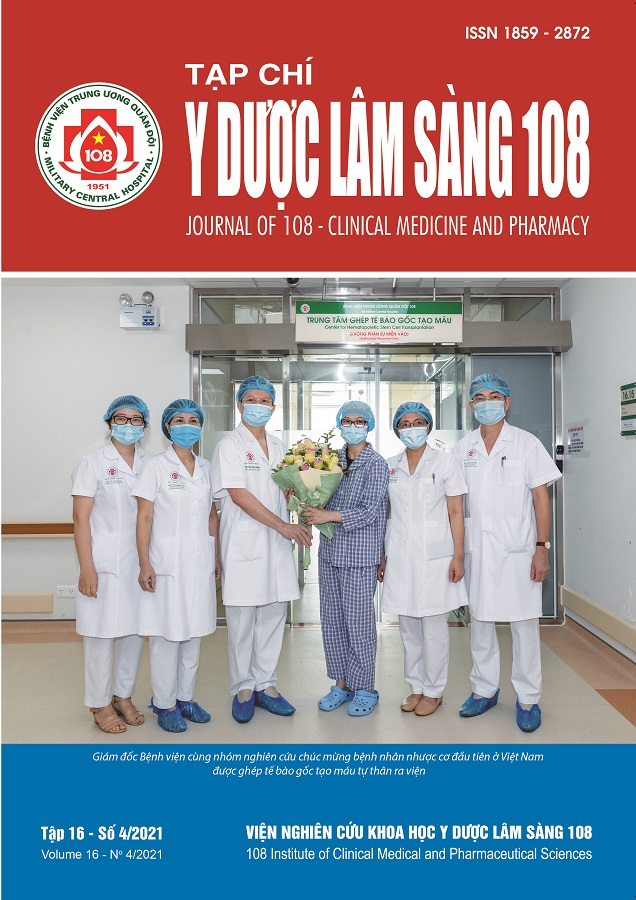Prostate artery embolization for treatment of benign prostatic hyperplasia: Outcome 6 and 12 months post-embolization
Main Article Content
Keywords
Abstract
Objective: To evaluate the midterm result of prostatic artery embolization technique for treatment of benign prostatic hyperplasia. Subject and method: A clinical intervention study on 66 patients with benign prostatic hypertrophy treated with prostatic artery embolization at Friendship Hospital from May 2015 to June 2019, evaluating treatment results based on changes in IPSS and QoL scores as well as clinical response 6 and 12 months post-intervention. Result: The average IPSS index pre-embolization was 30.8 ± 2.36, 6 months post-embolization decreased to 17.3 ± 2.5 points, equal to 56.2 ± 6.83%; 12 months post-embolization decreased to 15.3 ± 3.63 points is equal to 49.6 ± 10.99%. The mean QoL pre-embolization was 4.7 ± 0.46, decreased to 2.08 ± 0.73 points 6 months post-embolization and 1.77 ± 0.0.65 points 12 months post-embolization. Clinical response rate 6 months post-embolization was 89.4%, 12 months post-embolization was 80.3%. Factors that positively affect the ability to maintain clinical response after 12 months include: Prostate gland does not protrude into the bladder lumen, gland volume < 80mL, patient has prostatic artery embolization on both pelvic sites. Conclusion: Prostate artery embolization is an effective treatment, helping to improve symptoms and quality of life for patients with benign prostatic hyperplasia, the treatment effect is maintained in the midterm up to 12 months.
Article Details
References
2. Pisco JM et al (2016) Medium and long-term outcome of prostate artery embolization for patients with benign prostatic hyperplasia: Results in 630 patients. J Vasc Interv Radiol 27(8): 1115-1122.
3. Kuang M, Vu A, and Athreya S, Systematic A (2017) Review of prostatic artery embolization in the treatment of symptomatic benign prostatic hyperplasia. Cardiovasc Intervent Radiol 40(5): 655-663.
4. Ray AF et al (2018) Efficacy and safety of prostate artery embolization for benign prostatic hyperplasia: An observational study and propensity-matched comparison with transurethral resection of the prostate (the UK-ROPE study). BJU Int 122(2): 270-282.
5. Bilhim T et al (2016) Predictors of clinical outcome after prostate artery embolization with spherical and nonspherical polyvinyl alcohol particles in patients with benign prostatic hyperplasia. Radiology 281(1): 289-300.
6. Carnevale FC et al (2020) Prostatic artery embolization for the treatment of lower urinary tract symptoms due to benign prostatic hyperplasia: 10 years' experience. Radiology 296(2): 444-451.
7. Maclean D et al (2018) Factors predicting a good symptomatic outcome after prostate artery embolisation (pae). Cardiovasc Intervent Radiol 41(8): 1152-1159.
8. Yu SCH et al (2019) Thickness-to-Height ratio of intravesical prostatic protrusion predicts the clinical outcome and morbidity of prostatic artery embolization for benign prostatic hyperplasia. J Vasc Interv Radiol 30(11): 1807-1816.
9. Carnevale FC et al (2017) Recurrence of lower urinary tract symptoms following prostate artery embolization for benign hyperplasia: single center experience comparing two techniques. Cardiovasc Intervent Radiol 40(3): 366-374.
10. Hacking N et al (2019) Technical and imaging outcomes from the uk registry of prostate artery embolization (uk-rope) study: Focusing on predictors of clinical success. Cardiovasc Intervent Radiol 42(5): 666-676.
 ISSN: 1859 - 2872
ISSN: 1859 - 2872
